School Library Tech Budgets Rise | SLJ 2017 Technology Survey
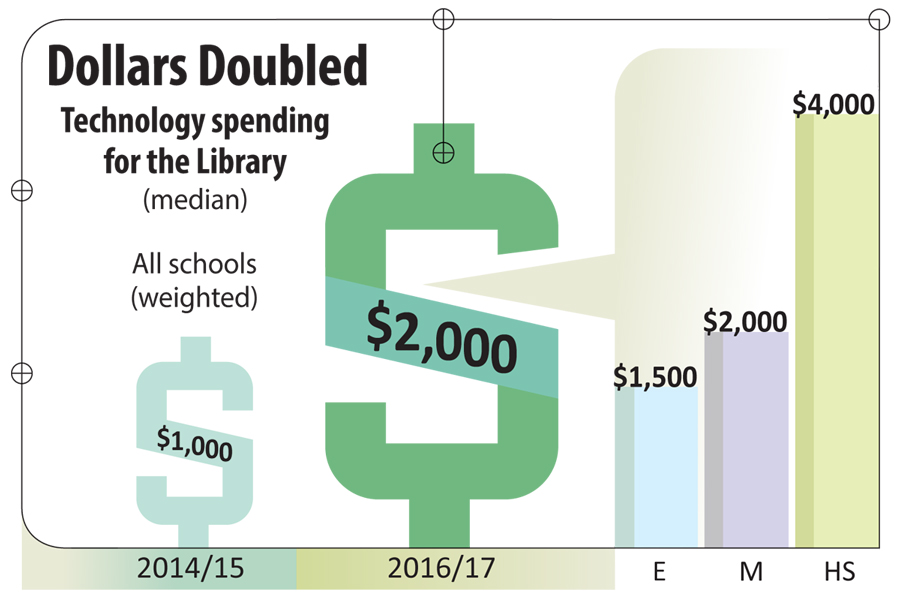
Click to enlarge
Chart Design and Illustrations by Jean Tuttle
School librarians are enjoying a technology boom as tech budgets blossom. As a result, new digital tools are making their way into classrooms, maker spaces, and school libraries.
Median spending on technology doubled in the last two years, from $1,000 during the 2014/15 school year to $2,000 for 2016/17, according to School Library Journal’s latest School Technology Survey. The survey was sent to newsletter subscribers last fall, with 1,037 responding. From robotics to virtual reality devices, cutting-edge tech is working its way into students’ hands.
Show, don’t tell
While budget bumps help with tech adoption, so does nimble promotional work by school librarians. They’re inviting school and district technology coordinators into libraries so they can see students’ use of tech for themselves. Respondents say 45 percent of the money they spend on technology stems directly from their school or district’s technology budget. It’s important, then, to make sure those who control those funds understand how the money gets used. While school librarians go about such advocacy in different ways, “show, don’t tell,” at least, seems to be going a long way.
Jennifer Wenzel, librarian at Muhlenberg Middle School in Laureldale, PA, personally invites her district tech coordinator to visit her library to see how students and teachers are using existing tech—and to talk about how they could integrate new technology into the space.
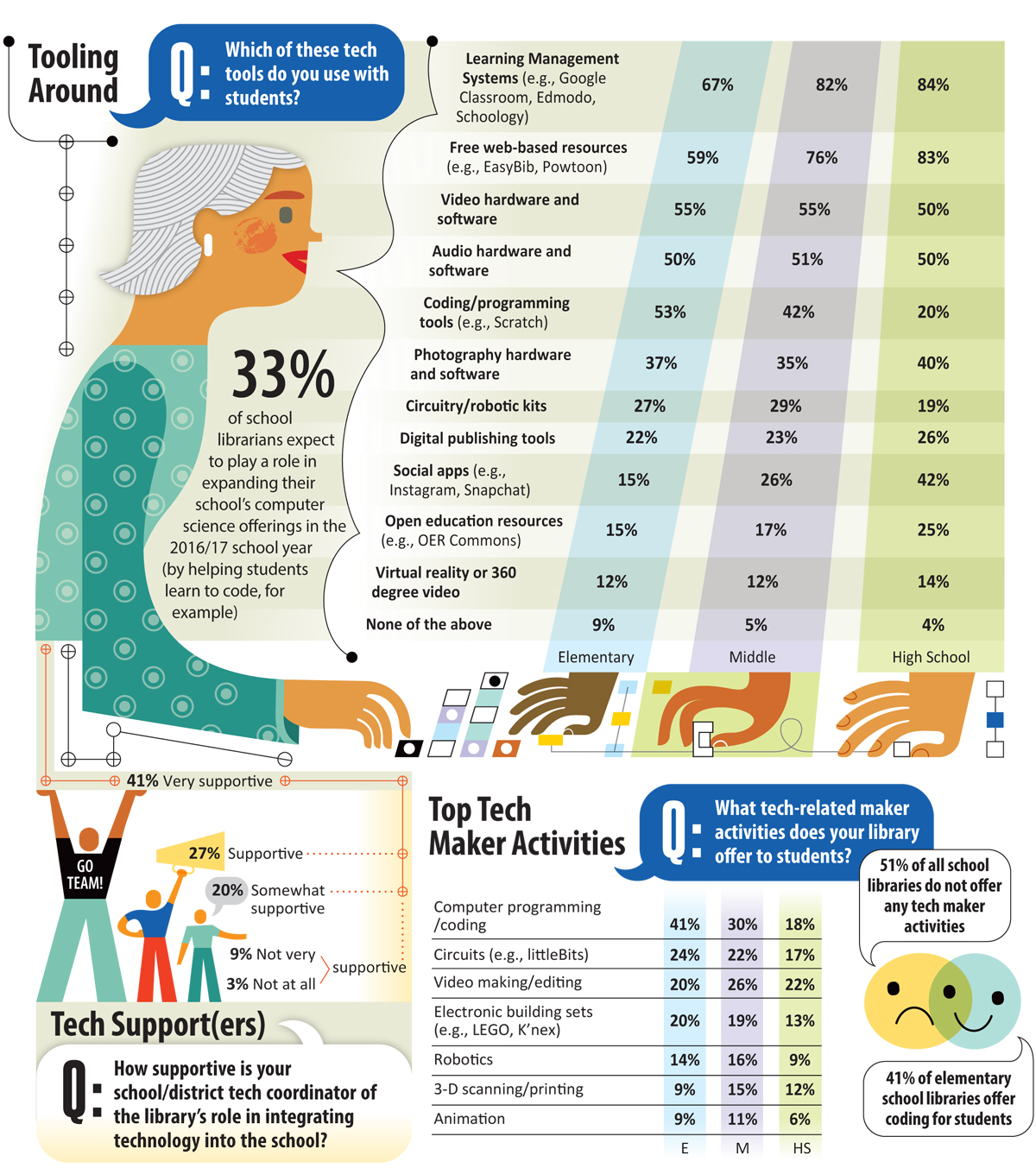
“Then in decision-making meetings, he has decent knowledge of our current status and our vision for the future,” says Wetzel. “It was awkward at first, but now he engages with students and understands their strengths and weaknesses, how long it takes to get things done, and why we need high-quality technology.”
Hannah Little, library director at the Webb School in Bell Buckle, TN, says that her maker space has become her technology director’s base of operation. “He loves to experiment with new technologies,” she says.
These on-site field trips are apparently effective. A whopping 68 percent of respondents say their school and district technology coordinators are supportive, or very supportive, of the technology school librarians are bringing into the schools.
Finally, one school librarian reports that if all else fails, extreme measures can be taken.
“Bring them candy often,” jokes Shara Weiss, the librarian at both Central High School and Central Middle School in Park Hills, MO, who has been working closely with students on programs including screencasting, which lets users make videos by recording what they do on their computer screens.
Enter VR
The newest technologies trending with consumers in general are also making their way into schools, and in particular the library, say respondents. More specifically, students are dabbling with virtual reality and 360-degree videos. VR goggles are in 12 percent of libraries, while three percent boast wearable technology, devices worn on the body that transmit data about the wearer.
Forty-nine percent of respondents note they have maker activities in the library, with options ranging from running 3-D scans to learning how to design for the web. Students are also experimenting with animated films, game design, and video production, along with engineering and robotic programming through electronic building sites, such as LEGO.com.
Even in schools where high tech isn’t the norm, school librarians are eager to learn how these programs and gadgets work, with 49 percent interested in diving deeper into virtual reality or 360-degree video, and 53 percent hoping to gain more understanding about circuitry and robotic kits, such as littleBits.
Lisa Wright, the school librarian at West Yadkin Elementary in Hamptonville, NC, “assists students with VR and green screen types of applications,” she reports. Meanwhile, Alison M. Brooks, the librarian at Apollo Middle School in Antioch, TN, adds that she’s teaching students how to use iMovie and green screen technology. She also uses Nearpod, online lessons, and “will hopefully get into the VR side.”
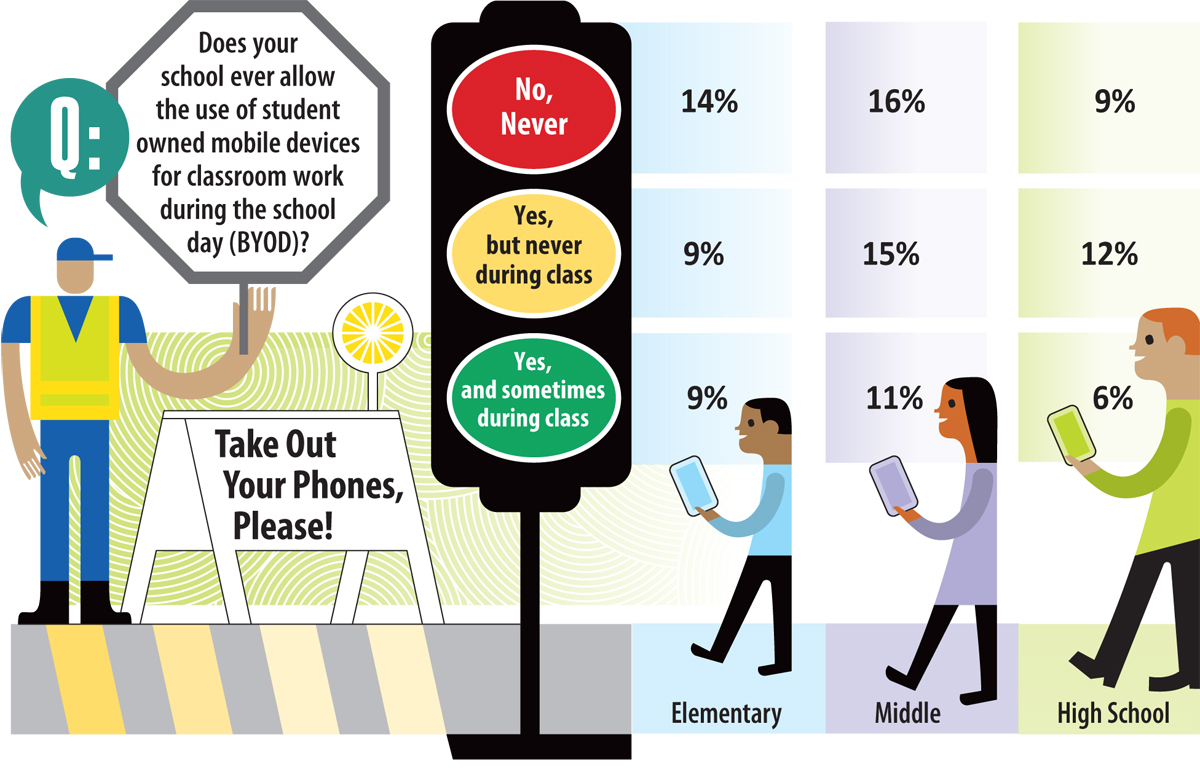
Yes to smartphones
One conduit for tech to settle into schools may be the kids themselves. Student-owned smartphones and other personal mobile devices are allowed—at least sometimes—in classrooms at 40 percent of schools. To that end, 34 percent noted that policies against using phones in classrooms are relaxing.
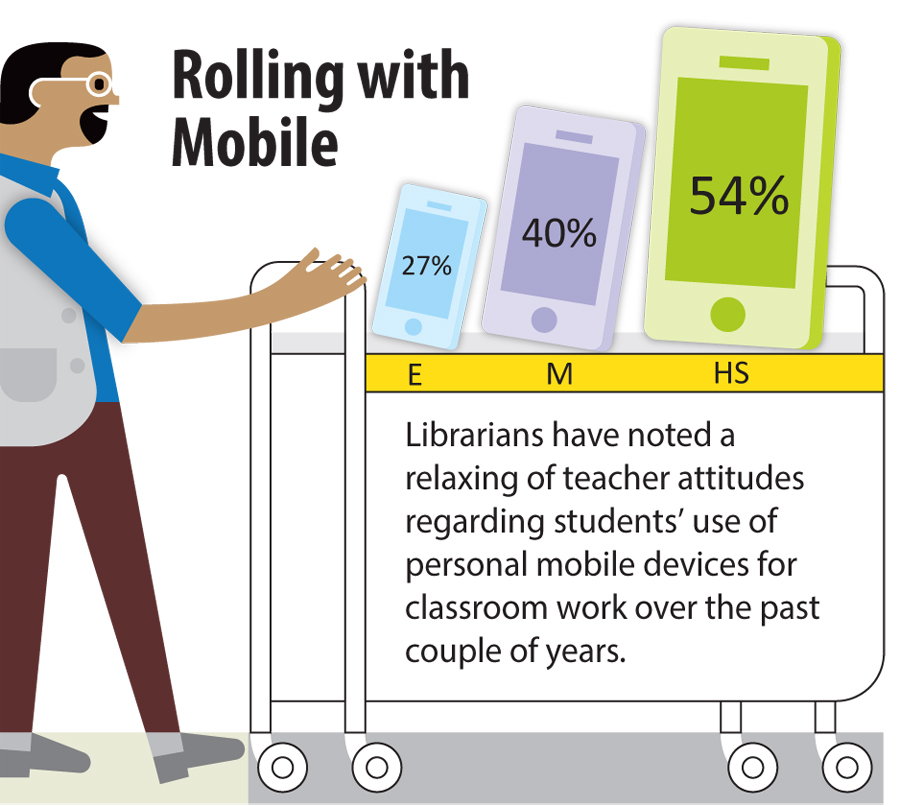
When they can use them, students are putting their handhelds to use as digital readers and calculators, app runners, class poll processors, as well as research and project helpmates.
In some cases, school librarians are selecting technology on the basis of whether it’s user-friendly and accessible via the Internet from any mobile device, “including cell phones, as that is the only way many students have access to the internet at home,” notes Jennifer Wright, a librarian at Beaver River Central School in Beaver Falls, NY.
Coding takes off
Opportunities to try computer programming and coding, with tools such as Scratch, are offered in 36 percent of school libraries. Of that group, one in five say they’ll be participating with students in the Hour of Code this year, an online-based event involving more than 200 tutorials.
Kathleen Gocksch, the school librarian at PS 008 Isaac Varian School in the Bronx, NY, is already in her third year of participating in Hour of Code with her students, she says. Students at River Dell Middle School in River Edge, NJ, already spend a week on the initiative. Librarian Mary Kay Risi is planning to expand on it even further by add coding resources in the maker space.
As coding champions, school librarians may be opening doors to students with no other way to learn it. No computer science classes at all are offered in 34 percent of schools.
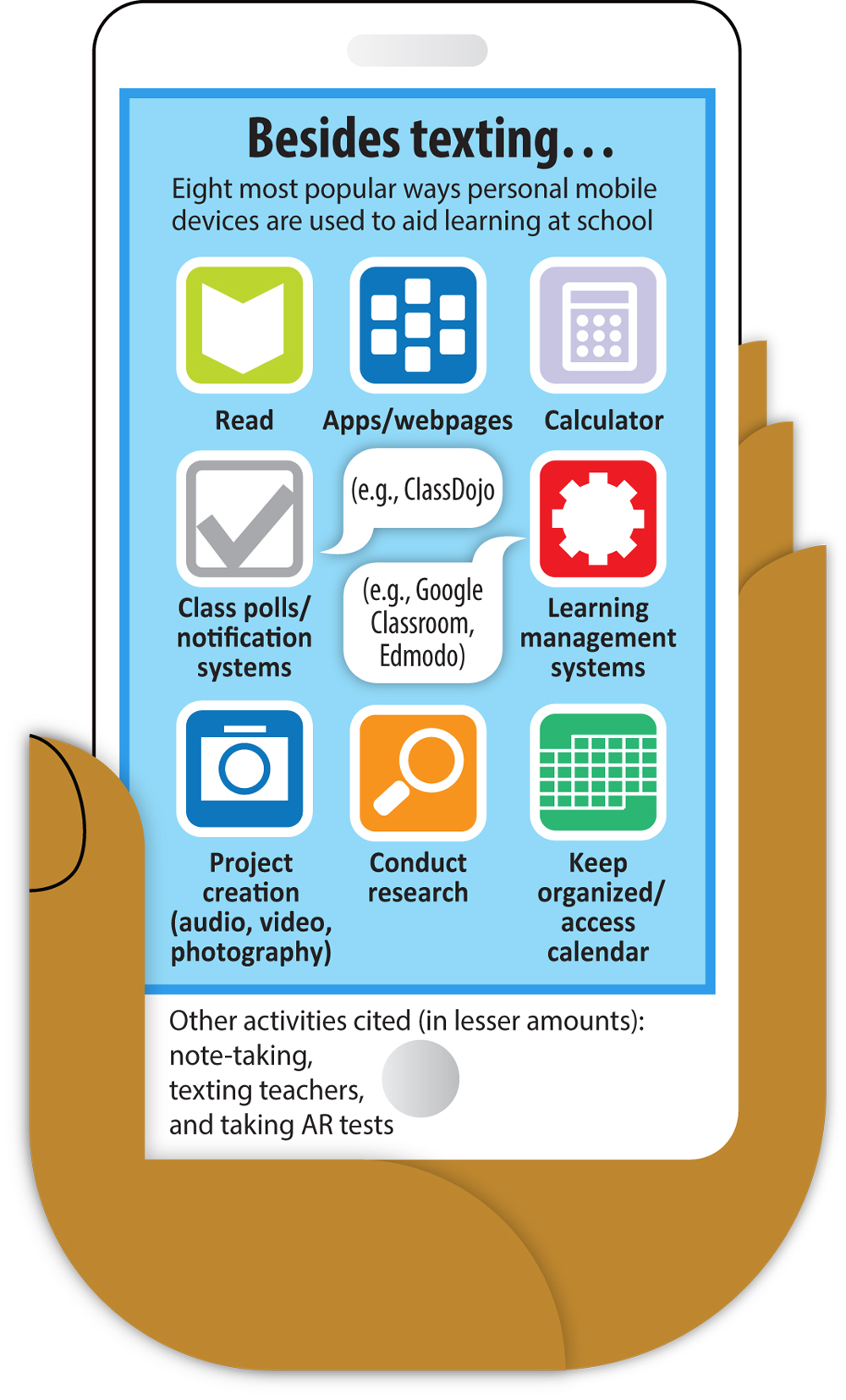
Limited access
Certain kinds of websites are off limits to librarians and students alike at school. One-quarter of respondents say they are unable to access YouTube, or streaming services, including Netflix and Pandora. One-third of school librarians say they can’t get on any social media sites at all; only 21 percent say they are using social media with students, while another 31 percent would like to learn how to weave it into classroom learning.
It’s possible these sites are off limits due to lack of bandwidth in schools. Bandwidth—the capacity for devices to transmit data online—is a concern for nearly one-third of respondents. Sites that push out video and music require substantial bandwidth.
That said, 68 percent of the survey respondents now report that they have “adequate bandwidth,” compared with 63 percent during the 2014–2015 school year.
Job security
As school librarians continue to introduce students to new technologies, they’re becoming known as tech experts in the process. That perception helps more of them feel secure in their positions. About 28 percent tied technology skills to job security in 2014–2015; that number jumped to 32 percent in the 2016–2017 school year. Interestingly, though, that number was 55 percent in 2012.
Leveraging that reputation for tech expertise, however, requires school librarians to advocate for themselves, their budgets, and the practical worth of the tech tools they want to bring to their students. It is crucial that administrators understand that the roles of a school librarian include technology integrator, information literacy teacher, curriculum developer, and staff professional development coordinator, says Brenda Lemon, Chapman (KS) Unified School District 473 librarian. “If they only see the school librarian as someone who ‘handles the books,’ then it’s easy to replace that person with a [para librarian]. Schools will then hire tech integration and curriculum specialists, not knowing that the school librarian can do those same tasks and more,” says Lemon.
Download the full report:
RELATED
The job outlook in 2030: Librarians will be in demand
The job outlook in 2030: Librarians will be in demand
ALREADY A SUBSCRIBER? LOG IN
We are currently offering this content for free. Sign up now to activate your personal profile, where you can save articles for future viewing






Add Comment :-
Comment Policy:
Comment should not be empty !!!